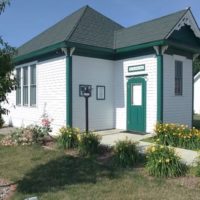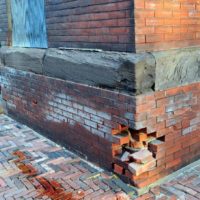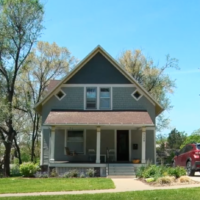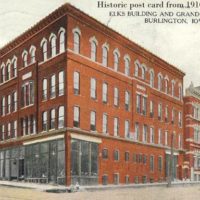Egloff House Among Homes City Working to Save
Posted by mw on December 26th, 2010 1:24 pm
Dec. 22, 2010
Media Contacts:
Juli Probasco-Sowers
Communications Director
Rebuild Iowa Office
(515) 242-5234 (o)(515) 249-1714 (c)Fax: (515) 242-5006
WORKING TO RECOVER: MASON CITY WORKS TO PRESERVE 11 HISTORIC HOMES DAMAGED IN 2008 FLOODING
Egloff House Among Homes City Working to Save
Note: More than $4.3 billion in disaster-recovery funds have been committed to Iowa since the 2008 floods and tornadoes. “Working to Recover” is an effort by the Rebuild Iowa Office to show how disaster recovery funds have assisted individuals, businesses and communities as the money flows out through recovery programs administered by local, state, federal and non-profit agencies. Volunteer efforts will also be highlighted. (DES MOINES) – Historic preservation of disaster-damaged structures plays a major role in Mason City’s continued recovery from the 2008 flooding.
City Planner Tricia Sandahl said the city is currently working to preserve 11 flood-damaged homes with historic value. These structures are among the 169 homes the city plans to purchase in a buyout plan created following the 2008 floods. As of Tuesday, 105 homes have been purchased by the city through buyouts, and 30 homes have been demolished.
The 11 historic homes will be stabilized and preserved for the short-term through the process called “mothballing,” which is used by the National Parks system, Sandahl said. Mothballing includes securing the house to keep animals and people from getting inside; making sure there is adequate ventilation so there is no mold growth; draining pipes and water heaters; disconnecting the water meter; putting stabilizing chemicals in the sewer traps; and mowing and removing snow from around the homes when needed.
The city estimates this type of temporary preservation will cost between $40,000 and $50,000 overall, funds which will be provided through the Federal Emergency Management Agency (FEMA). As part of the agreement with FEMA, Mason City must keep the structures stable for up to two years, during which time the city must market the homes, Sandahl said. The ultimate goal is to sell the homes to people who want to move the structures to new locations. At the end of two years, however, any structures which aren’t sold could be demolished.
One of these homes is the Egloff House in the Oak Park neighborhood along the Winnebago River. The unusual, European-style home was built in 1938 for Dr. William Egloff and his wife, Margaret, explained Sandahl.
Richard Cone, an architect known for designing commercial structures, designed only two homes in his career, one of which was the Egloff House, which he designed for his sister who was Margaret Egloff. It was the first house in Mason City to be air conditioned, using what is known as swamp coolers which serviced the house until the 2008 floods. Living room walls are still covered with original wallpaper, some made of woven grass and some of wood veneer, Sandahl said.
“Dr. Egloff was a sailor. That love of sailing certainly comes through in the way the house is designed,” she said. A compass rose medallion made of linoleum can still be seen on the family room floor. Every inch of the 3,000-square-foot house is put to use, much like space on a sail boat, Sandahl said.
“We don’t know yet if we can move the Egloff house, and we are doing more evaluation to see if we can,” she said. The intricate nature of the construction makes the home more delicate to move. This floor system, called the Sheffield Tile Deck System, was patented by an Iowa State University professor in 1936, and the tiles were manufactured at the Sheffield Brick and Tile works in Sheffield, Iowa. The tiles are made of the same clay used to make bricks and flowerpots, and were considered state-of-the-art for 1938. However, if one of the tiles shifts in a move, the house will become structurally unstable.
The city will investigate the possibilities of moving the Egloff House by using a multi-disciplinary team which includes an architect, structural engineer, architectural historian, house mover and a real estate professional to prepare a structural relocation feasibility study.
Preserving the house would keep an important piece of Mason City History from being lost, Sandahl said. The house has served as the anchor in a historic district that will disappear because of the buyouts. It is her hope that the house will be acquired and moved. “If we can’t move it, we will document the home, remove some architectural details from the house for re-use, then tear it down,” Sandahl said.
The city will also use Community Development Block Grant funds to purchase and preserve 14 homes in addition to the 11 historic homes mentioned above. While many of the 14 additional homes have some level of historic value, some are simply homes in good enough shape to be moved out of the flood-damaged areas and rehabilitated.
The city is currently exploring options for funding to help with the cost of rehabilitating the homes. Habitat for Humanity has also expressed interest in purchasing and moving a few of the homes.
Additionally, city officials plan to preserve the historic and architectural significance of other homes through continuing archival efforts. The city is documenting all of its historical structures destroyed by the flooding through written histories and photographs. In some cases, historical features of the house are being salvaged for future re-use in the community. Historic information about the flood-damaged homes will be housed, at least temporarily, at the Mason City Library.
Contact for the media:
· Tricia Sandahl, City Planner, Mason City (641) 421-3626
To find out more, go to: www.rio.iowa.gov








